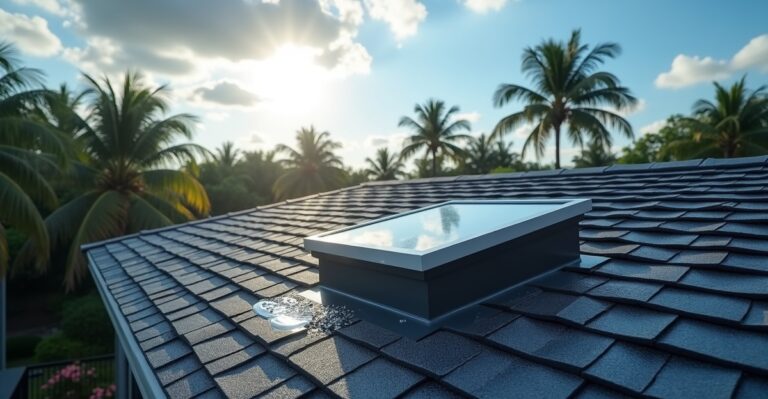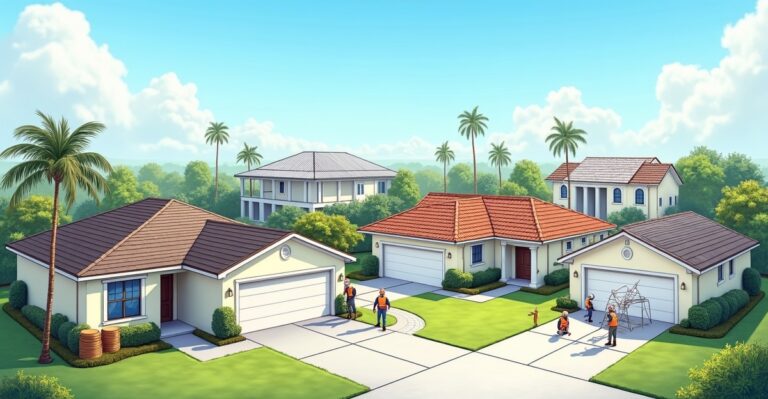Can I Repair a Roof Leak Myself?

Fixing a roof leak yourself in Florida can work in some cases. With the right tools and experience, we can address smaller problems. However, many leaks signal hidden or serious damage. Florida’s climate adds pressure, with frequent storms, high humidity, wind-driven rain, and the constant threat of mold. Before picking up a ladder, we need to think through the risks and evaluate if a DIY fix makes sense.
Key Takeaways
- Minor issues like a few missing shingles or visible nail heads might be manageable for experienced DIYers using the right gear.
- Leaks that appear after storms or hurricanes often stem from structural damage that needs a professional to examine and repair.
- Steep pitches, slippery surfaces, or working on homes with more than one level raise serious safety concerns—these conditions aren’t safe for DIY efforts.
- Water that keeps coming back, saggy areas beneath the roof, or signs of mold indoors usually point to deeper damage we shouldn’t tackle alone.
- Trying to fix major roof problems without training can make things worse. It may also cancel your warranty or affect insurance claims if not done correctly.
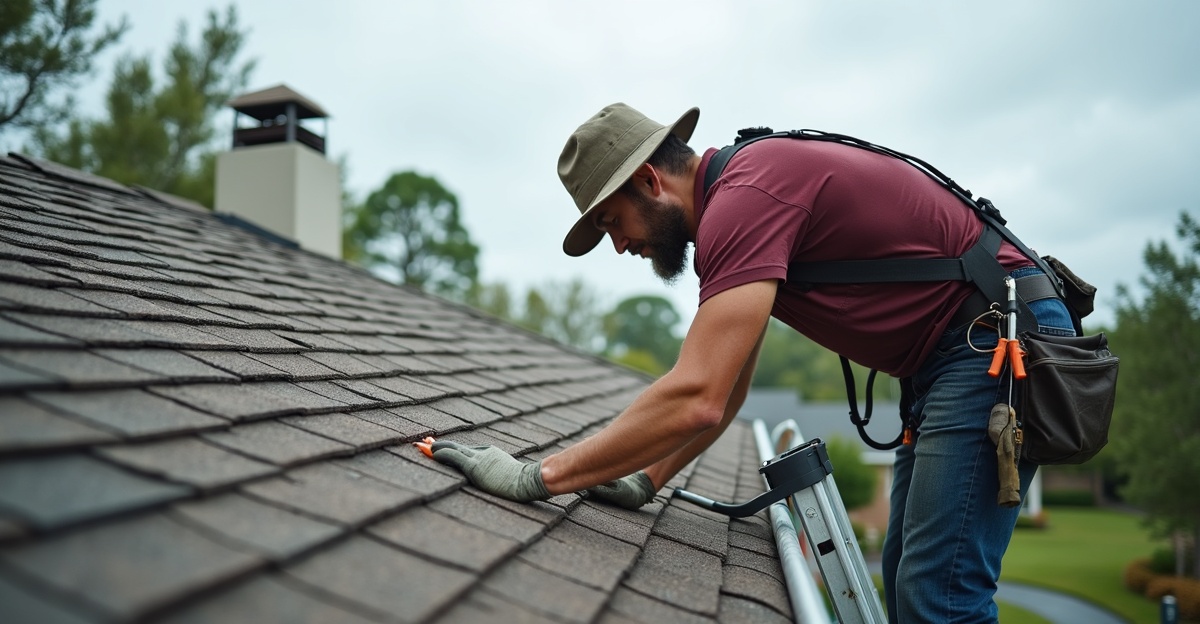
Can I Repair a Roof Leak Myself?
Fixing a roof leak on your own might seem like a smart way to save money, but it depends on a few key factors: your experience, the type of roof, the size of the leak, and most importantly—safety. While small issues like a slipped shingle or a tiny puncture might be within reach for a handy homeowner, more serious leaks could spell bigger problems beneath the surface.
We’ve seen plenty of cases where a quick patch job at home only masked deeper damage. Sometimes what looks like a single leak in the ceiling is part of a wider issue with flashing, underlayment, or ventilation. That’s why it’s smart to weigh your options carefully before climbing the ladder.
What to Consider Before Taking on Repairs
If you’re thinking about handling a leak yourself, ask the following questions before pulling out the toolbox:
- Where is the leak coming from? If water is dripping far from where it’s entering the roof, you’ll need to track it across rafters or insulation. That can be tough without experience.
- How steep or high is the roof? Safety first. If the slope is steep or the materials are slippery (like tile or wet shingles), it’s best not to risk a fall.
- Do you have the right tools? Roofing cement, sealant tape, flashing materials, and PPE are essentials for even small fixes.
- Has the damage been caused by a storm? If storms triggered the leak, we recommend a full inspection. Storm damage often affects more than one spot and may be covered by insurance. For these cases, consider our storm damage repair services.
Some homeowners feel confident handling minor repairs. These may include:
- Replacing a single lifted or cracked shingle
- Applying roof sealant to small nail holes
- Re-securing loose flashing around chimneys or vents
- Cleaning debris in gutters to prevent pooling water
But even small leaks can become larger concerns. Water can rot decking, destroy insulation, or promote mold growth. If you’re unsure about what lies under the surface, it’s often best to call professionals for inspection. You can find more specific guidance in this helpful article: can a roof be repaired instead of replaced?
When It’s Better to Call a Roofing Professional
While we respect a good DIY spirit, here’s when it’s wiser to bring in a crew that’s trained and insured:
- Leak has caused ceiling stains or mold
- Water appears after heavy winds or hurricanes
- You see cracked or curling shingles in multiple spots
- There’s visible damage to flashing, vents, or the valleys between roof slopes
- The roof is near the end of its expected lifespan
For shingle roofs in Florida, that lifespan typically ranges from 15 to 25 years depending on the material and maintenance. Learn more in our breakdown on how long shingle roofs last in Florida.
At this point, what looks like “just a leak” may be a sign of larger aging issues. You can get a clearer sense by reviewing the signs your roof needs replacement.
And if your leak is related to roof ventilation or under-eave damage, our crews also handle specialized repairs for fascia and soffit problems and roof ventilation systems.
We care about our community’s safety and property values. Whether you’re tackling a small drip or facing a more involved leak, we’re here to help. Our roof repair services are built to match Florida’s unique roof challenges—especially with year-round heat and storm concerns.
Still unsure about the scope of your leak? Don’t guess. Snap a few photos, note when it leaks most, and reach out through our contact page. We’ll give you honest feedback and next steps.
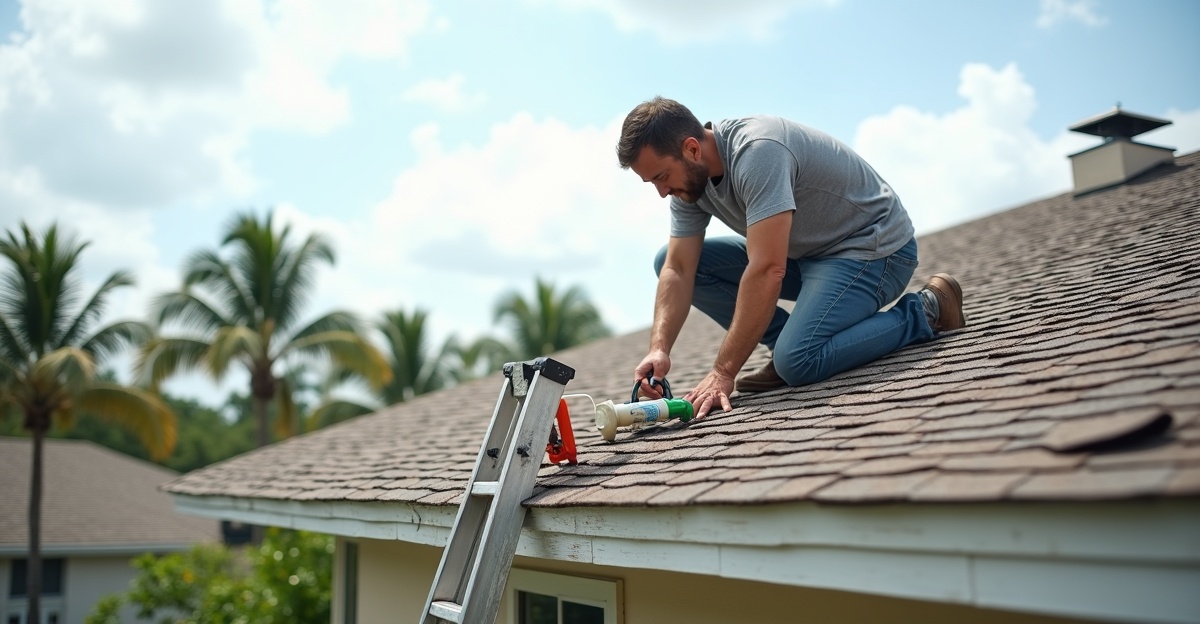
Can I Repair a Roof Leak Myself?
When a DIY Fix Might Work
We’ve seen some homeowners manage small leaks safely and effectively—especially when the problem is obvious and easy to reach. If the damage is limited to a missing shingle, a loose nail, or a crack in the flashing, there’s a chance you can apply a short-term fix until a professional steps in. But it’s worth weighing your comfort level, the height and slope of your roof, and what materials you’re working with.
Here are a few scenarios where a do-it-yourself patch might work in a pinch:
- Loose or missing shingles near the eaves
- Minor flashing gaps around a chimney or vent
- Small punctures from fallen debris
- Clogged gutters causing water backup
Using roofing cement or a temporary sealant can slow the leak, but these are not permanent fixes. In many cases, what looks like one damaged area might be a sign of wider wear. If you’re unsure whether it’s something you can manage or a deeper issue hiding underneath, we’re always ready for a quick assessment.
Why Some Leaks Need a Professional
Florida’s storms, humidity, and heat wear roofs down faster than in other parts of the country. What starts as a drip might come from water traveling across joists or soaking into insulation before you see the damage. That’s where experience matters.
High-risk fixes often involve:
- Unseen water damage
- Mold or sagging decking
- Worn roof valleys or underlayment
- Multiple missing or cracked shingles
Trying to fix a leak without knowing its source can lead to more expensive repairs later. A common mistake we see is sealing a visible crack while the real leak starts several feet above. That’s why we recommend reading up on whether a roof can be repaired or needs replacement to better understand your options.
Professional inspections go deeper than surface damage. We check for structural changes, identify secondary issues, and match repairs to the type of roofing you have. For example, shingle systems wear differently than flat roofs. If you’ve ever wondered about lifespan, take a look at how long shingle roofs typically last in Florida.
For leaks caused by storms, the safest choice is to schedule a no-pressure consultation through our storm damage repair services. We’re fast to respond and can help file insurance claims if needed.
And if you’re just starting to see early signs of wear—like discolored ceilings, curling shingles, or strange drips—this guide on signs your roof might need replacement outlines what to watch out for.
Leaking roofs shouldn’t be ignored, but you don’t have to handle them alone. Whether it’s a basic patch or full repair, our roof repair team is here to help, no guesswork required.
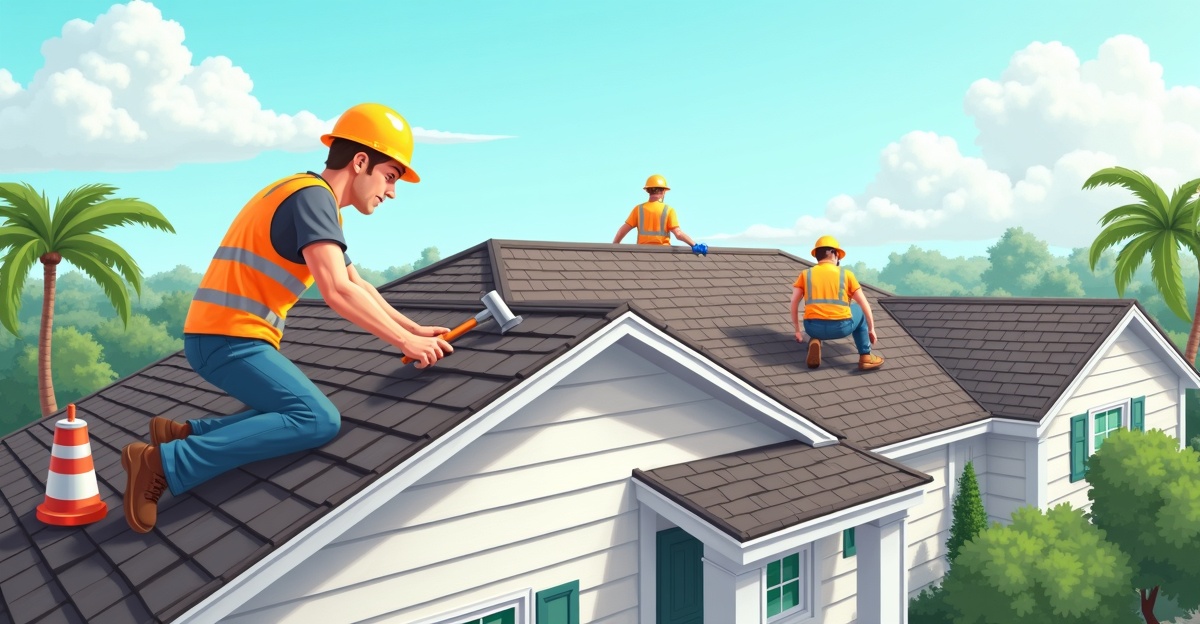
When It Makes Sense to Tackle Roof Leak Repairs Yourself
Minor Issues You Can Usually Handle
Not every leak needs a full crew. Some smaller repairs can be managed with a careful eye, basic tools, and a dry day. Here are a few common leak sources that homeowners with basic DIY skills might be able to fix:
- Missing or loose shingles: If you spot a few shingles that have blown off or lifted, replacing them can be relatively simple with the right materials and safety precautions.
- Exposed nail heads or popped nails: These can let water in. Sealing them with roofing cement or replacing the nails with screws and rubber washers can help stop a leak.
- Cracked or deteriorating sealant around flashing: Areas around vent pipes, skylights, and chimneys often have old sealant that can be cleaned off and replaced to stop seepage.
- Small holes in flashing or under shingles: Roofing tape or a patch of flashing with sealant can offer a short-term fix.
We usually recommend tackling only what’s easily visible and reachable. If a repair means climbing steep pitches, removing large roof sections, or cutting into decking, it’s safer to leave it to pros. Small patches might buy time, but bigger issues often sit just beneath the surface.
When DIY Just Isn’t the Right Call
Some repairs are better left in experienced hands—not because they’re impossible, but because risk, cost, and long-term results matter. If any of the following apply, we advise calling a trusted roofing professional:
- Signs of widespread damage: If multiple areas leak or shingles are curling, lifting, or missing in large numbers, it’s no longer an isolated patch job.
- Interior ceiling damage or mold: Water inside your home signals deeper issues. It may mean the leak has gone unnoticed for too long or extends far from the visible source.
- Leaks after a storm or hurricane: Storm damage often runs deeper than surface issues. Our licensed crew is trained in assessing and handling these impacts safely. Learn more at our storm damage repair services.
- Structural rot or decking deterioration: If water has compromised the wood below your shingles, a fast patch won’t fix it. This level of repair requires replacing materials to restore integrity.
- Ongoing leaks that keep returning: Persistent problems usually mean something’s being missed—whether in design, materials, or the initial repair.
In Florida especially, the weather demands durable fixes, not temporary band-aids. That’s why we emphasize prompt attention paired with solutions built for the climate. If you’re unsure whether your roof needs professional attention, this guide on whether a roof can be repaired instead of replaced may offer helpful perspective.
If tackling a leak yourself feels uncertain, we’d be glad to offer a no-pressure inspection to help assess the best path forward. For more serious leaks or anything that threatens your safety, our roof repair services offer expert support you can count on.

When to Call a Professional
Knowing the Limits of DIY Roof Leak Repairs
Some minor roof leaks may seem simple to patch up. A few missing shingles or a small puncture might feel manageable with basic tools and tutorials. But not every leak is harmless, and guessing can cost more down the road. If we misjudge the damage or overlook hidden issues, we may end up with mold, damaged insulation, or even structural problems.
Here are situations where bringing in a professional makes more sense:
- Widespread water stains on ceilings or walls, which may signal leaks from multiple areas.
- Leaks near chimneys, skylights, or vents, where flashing and seals require skilled workmanship.
- Sagging spots on the roof deck, which might indicate trapped moisture and soft wood.
- Roofing materials older than 15 years, especially in Florida’s high heat and storm-prone climate.
- Visible storm damage after high winds or hurricanes—missing shingles, branches on the roof, or loose gutters.
Leaks aren’t always where they look. Water often travels along beams before pooling or dripping inside. A professional roofer understands these pathways and can track damage accurately.
Benefits of Hiring a Licensed Roofer
Bringing in a qualified team gives peace of mind you can’t get from a temporary fix. It’s not just about patching a leak—it’s about tackling the root problem quickly and preventing more serious damage.
These are some of the key advantages professional roofers bring:
- Proper diagnosis – We look deeper than surface-level signs, spotting weakness before it becomes extensive damage.
- Safety precautions – Roofing work risks injury without the right gear, especially on steep or slippery surfaces.
- Quality materials – Pros use industry-grade sealants, flashings, and shingles built for Florida weather.
- Long-term savings – Fixing it right the first time avoids repeat leaks or premature replacement.
- Warranty coverage – Repairs performed by licensed contractors often come with guarantees for added protection.
If the problem turns out to be bigger than expected, like storm-related issues or deeper moisture damage, we’re equipped to handle it. That’s where something like our dedicated storm damage repair service can step in to restore both function and appearance efficiently.
Many homeowners want to know if there’s a way to avoid full replacement. Depending on the extent and cause of the issue, a leak may be repairable instead of replaced—but only after an in-depth assessment.
We always encourage catching damage early. If your shingles show curling, cracking, or bald spots, there might be more happening underneath. You can learn more about warning signs with our guide on when a roof needs replacement in Florida.
If you suspect your roof is leaking, don’t wait. Reach out to experienced pros who know Florida homes, humidity, and hurricanes. You can get started through our roof repair service for quick answers and reliable solutions.
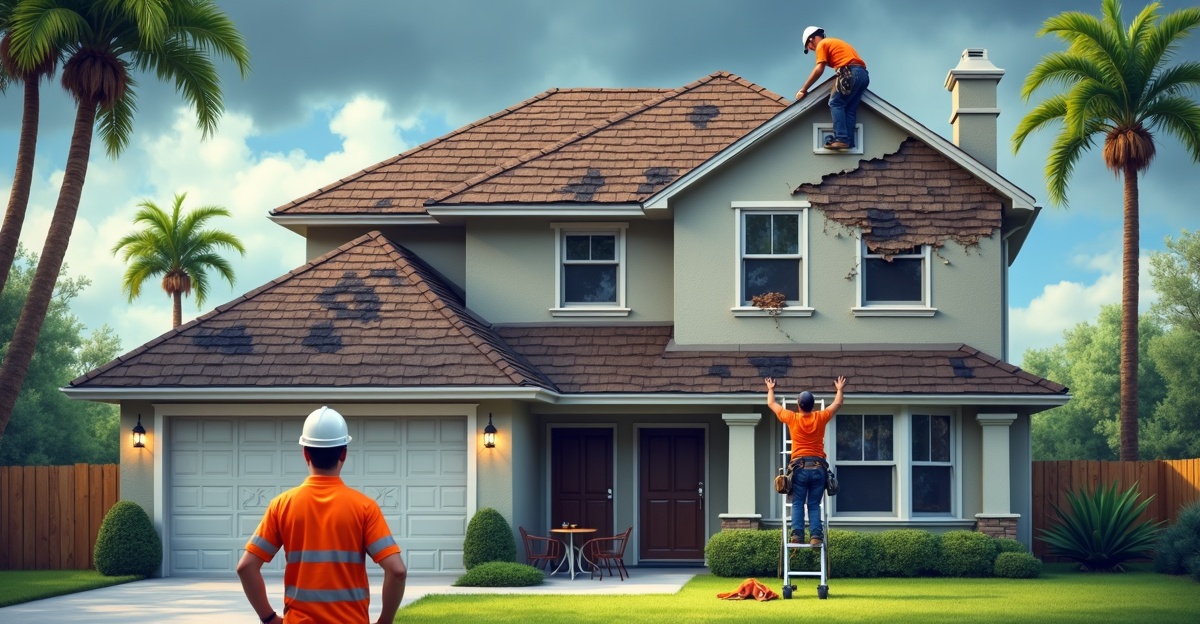
When It’s Better to Call a Professional Roofer
Leaks often start small. A few missing shingles or a minor crack around a vent might seem easy enough to handle. But even a tiny mistake can let in water that spreads fast, leads to mold, or ruins insulation and drywall. If we’re ever unsure where the leak is coming from or what’s causing it, it’s time to call in a pro.
Key Situations Where Professional Help Makes Sense
Some leaks come with clear signs that point to damage beyond what’s safe or practical to attempt ourselves. In these cases, bringing in a licensed roofing team protects both our homes and our safety. Here are the most common situations where hiring a professional is the smart move:
- The leak source isn’t obvious
If water’s showing up somewhere inside but we can’t find the exact spot on the roof, a roofer has the tools and experience to track it down quickly and accurately. - Shingles or decking are rotting or sagging
If we walk on the roof and it feels soft—or we see visible sagging—it could mean water has compromised the structure. That’s not a surface-level repair. That’s a job for trained pros. - We have repeated leaks or long-term problems
If the same spot keeps leaking again after patching it up, there may be a deeper issue with flashing, roof slope, or underlayment. A contractor can assess why short-term fixes won’t hold. - We’re dealing with storm or hurricane damage
High winds can lift, crack, or remove shingles completely. Rain can drive water up under weak seals. After major weather, it’s safer to let experts inspect for hidden damage. Learn more about how hurricanes damage shingle roofs in Florida if you’re unsure what to look for. - There are multiple leak points or large affected areas
One corner might be manageable. Spreading leaks across several spaces? That’s a strong sign that part of the roof—or possibly the full system—has reached the end of its life. A professional can walk us through whether a roof can be repaired or needs full replacement. - Safety is a concern
Steep slopes, high edges, slick surfaces, and Florida heat create real risks. If we’re ever uncomfortable climbing or working on our roof, even with the right gear, it’s just not worth it.
Even if the damage seems minor, inspecting the roof might reveal underlying problems we’d miss on our own. Getting help early can save time, money, and extended water damage.
We also consider long-term value. A DIY patch may hold up for a few months, but a professional repair typically includes a warranty and ensures the entire roofing system stays sealed correctly.
Want to know what repairs usually cost? Check out this guide on roof repair pricing in Florida to get a better picture of what to expect.
We handle a wide range of repair needs, from damaged flashing to worn shingles to persistent leaks. For help pinpointing and stopping water intrusion fast, explore our roof repair services. We’ll inspect the issue and provide honest recommendations that focus on safety and durability—without pressure.
If we suspect age is a factor, it’s worth checking how long your roofing material typically lasts. For example, learn more about how long shingle roofs last in Florida based on climate and materials.
If the signs are pointing toward aging materials or repeated damage, it may be time to evaluate replacement options. This article on the signs that your roof needs replacement gives some helpful indicators of when a patch isn’t enough anymore.
Our team is here to make it easier. We’ve worked on countless roofs across Florida, giving homeowners peace of mind they can count on. Let’s keep your home protected—together.
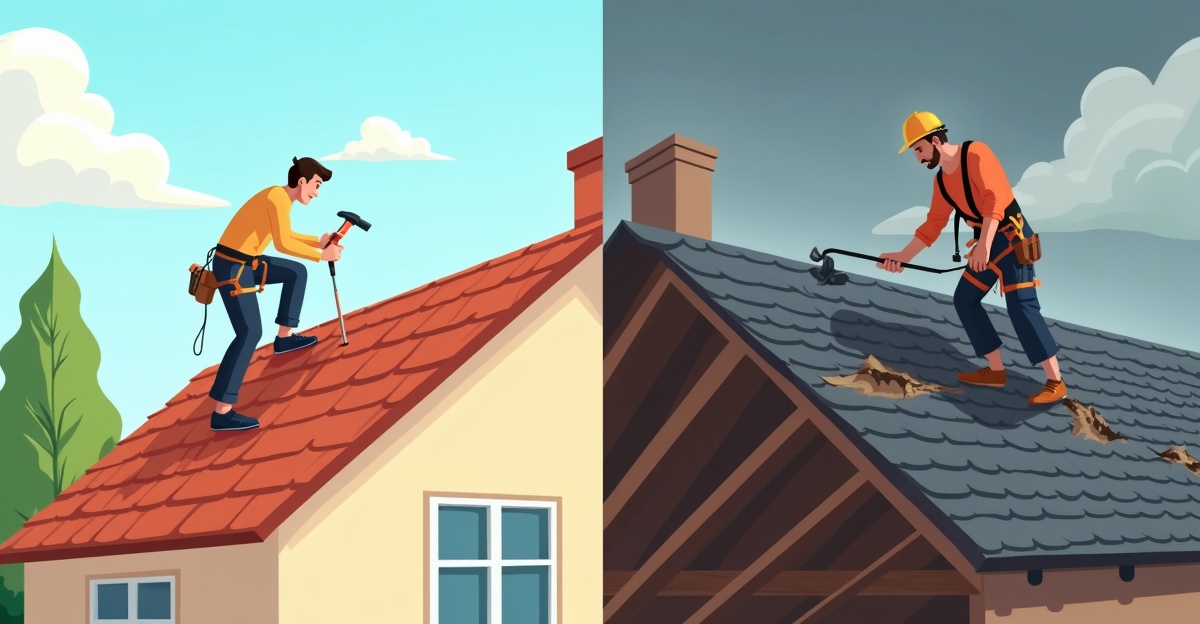
Knowing When to Call a Professional vs. DIY Roof Leak Repair
Taking on a leaky roof ourselves might sound like a smart way to cut costs, but some jobs demand more than a ladder and a tube of sealant. It’s all about knowing our limits—when a simple fix is safe to handle and when calling in a pro will protect our home and wallet long-term.
Signs It’s Time to Bring in a Roofing Expert
There are certain situations where professional help isn’t just smart—it’s necessary. Here’s when we recommend picking up the phone:
- Widespread or recurring damage: If leaks keep coming back or we’re noticing stains in more than one area, there may be issues under the shingles that a quick patch won’t fix.
- Structural concerns: A sagging roofline, cracked rafters, or waterlogged decking all point to potential structural damage where professional assessment is critical.
- Steep slopes or multi-story homes: Even if the repair seems simple, steep or high roofs increase fall risk and make specialized safety equipment a must.
- Signs of storm damage: After high winds or heavy storms, the cause of a leak might not be visible from the ground. Professional inspections can reveal hidden issues. To understand the extent of possible issues, check out how storms affect roofs by reading more about hurricane damage on shingle roofs.
- Mold or rot inside: Indoor signs like mildew or sagging ceilings hint that leaks have gone deeper than a surface shingle problem.
Ignoring these signs or attempting a DIY fix in these cases risks safety and likely costs more in the long run. Repairs dealing with wood rot, underlayment failure, or widespread material damage need professional tools and experience.
We often hear the question: can a roof be repaired instead of replaced? The answer depends on the age of the roof, the materials used, and the extent of the damage. If the roof’s nearing the end of its lifespan, full replacement may be smarter. But small, isolated leaks on newer roofs can often be fixed quickly by pros within a single visit.
If we know the damage is localized and we’re confident in our ladder safety and tool skills, small repairs might be manageable. But keep in mind—insurance coverage often requires professional repair documentation, especially if weather plays a part in the issue. Hiring a local, trusted team for roof repairs can save time, prevent deeper damage, and ensure warranties stay valid.
Not sure where your repair falls? We’re here to help, whether we’re checking for storm-torn shingles or advising on rot hidden beneath decking layers. Let’s make sure our homes stay protected with smart choices and teamwork between neighbors, contractors, and communities.

